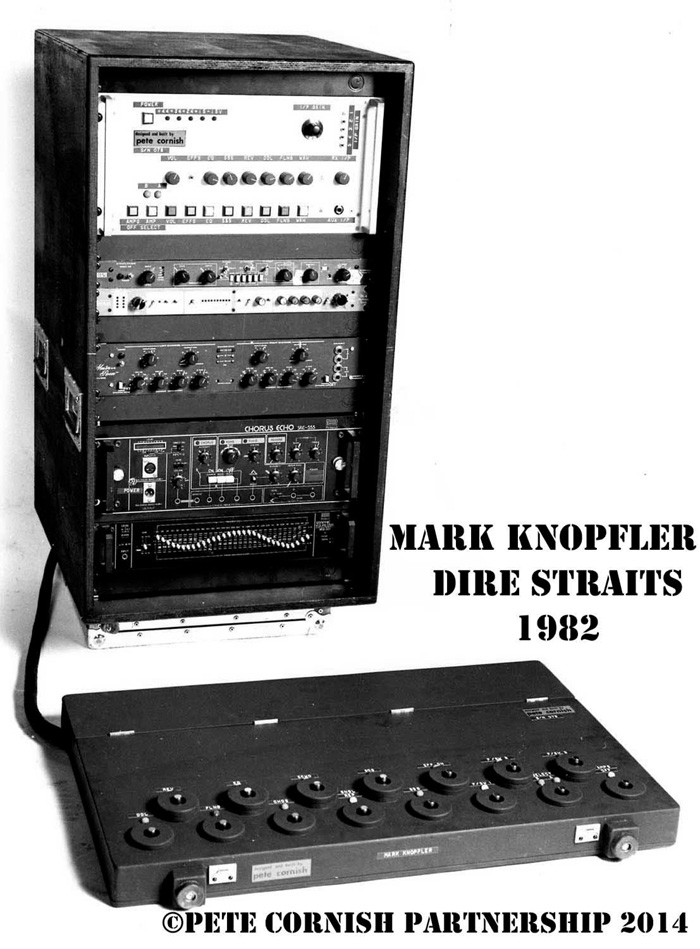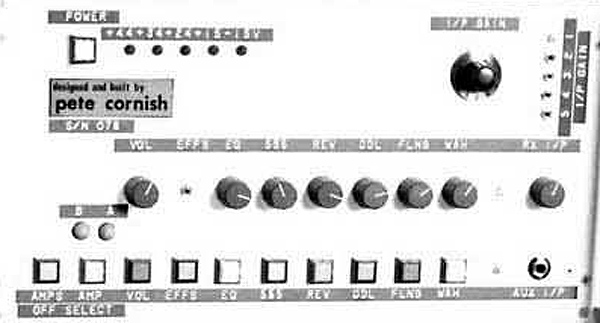From 1980 on, Mark’s guitar effects were mainly integrated into huge rack systems. At the time of Dire Straits, these were designed and built by Pete Cornish, specialist on high-quality racks and effects for numerous big names like Mark Knopfler, Eric Clapton, David Gilmour, Lor Reed, …
Pictures of Mark’s racks however are extremely rare, mainly because the rack was often located behind the stage, and at least partly operated by Mark’s guitar technician from there.
Recently Pete Cornish published some unseen pictures of two of Mark’s racks on his Facebook page. One of them shows the rack of the Love over Gold tour (I will cover the other rack in a coming blog post). In fact it is the first time we see this rack at all I think.
In the following, I will try to explain as many details I can make sense of. If you think you can add something, use the comment function at the bottom of thispost (no registration required). So, first of all here is the picture itself.

The Cornish racks follow the same logic that is true for effects used in the studio: most effects sit in a dedicated aux way (send / return), thus the path of the direct guitar signal is kept short and simple. (Note that however, not all effects can be used as aux effects but only those who “add” some effect to the dry signal. Effects that also might “reduce” something of the direct signal must sit in the direct path, e.g. compressor/limiter, EQ, distortion,..)
Cornish uses buffers on many locations within his racks. These can colour the sound is an intended way. The foot remote control is a wooden case of heavy-duty waterproof multiplex wood, all switches are normally military-grade quality products.
The control unit

On top left, we can see the power indicator / power button. I think that those square button-like elements are push switches that glow in different colours when switched on. I am not sure of the five elements we see next to the power button, I cannot read the description properly … does it end with … 15 – 15 V? So we possibly have indicator LEDs here that might show the presence of different voltages to run the rack, or the input or output level of the signal.
On the top right, we have what looks like a rotatory switch labelled with something like “1/P Gain” (or I / P ?). The same description can be found a bit more on the right where other five elements are located, labelled with numbers 1 to 5. I guess the rotary switch has five positions, and the selected one is indicated with an LED. It might be the gain of the first input stage, this would make technically most sense to me. On the other hand, the “P” makes me think of “parallel” so it might also be about gain of the send/return paths. This might go together with the two elements right below this section, which seem to be a control and a jack labelled with “?X 1 / P” and “AUX 1/P”
The serial number of the rack is 078.
Next we have a line with 8 controls and many of those square switches that partly correspond with the controls. The controls seem to read “VOL” , “EQ” “555” (= Roland Space Echo 555), “REV” (Reverb), “DDL” (I guess Deltalab Delay or digital delay) “FLND” (Flanger DynaFlanger”, and “Wah” (well, Mark used a wah for at least It never rains on that tour).
I suspect these controls to be rather return levels (and thus controlling the actual effect depth of the corresponding effects). The corresponding switches might mute or enable the respective effect path (alternatively, these can be switched with the foot remote control).
Between the VOL and EQ controls, we have a “EFFS” switch, I guess it is a master switch to enable or bypass all effects.
One of the two buttons on the left seems to be an “AMP SELECT”, with two LEDs for amp A and amp B, and the other one is “AMPS OFF” and will mute the signal to the amps.
I am not sure if VOL is simply a master volume control, or if it has to do with the volume pedal. Also is is unusual to have a path for the wah as normally a wah is not used in an aux way.
The effects
Below we see the different rack effects. These are partly identical to the ones used on the previous On Location (Making Movies) tour. A description of these effects can be found in the blog post about that effect rack.
The effects are (from top to bottom):
MicMix DynaFlanger
Deltalab Digital Delay DL-4
MicMix Master Room Reverb XL-305
Roland Space Echo SRE-555
Roland Graphic Equalizer
The foot remote control unit
With the foot remote control unit, Mark could enable or bypass the different effects.

We see 15 foot switches. Each one seems to have a corresponding status LED (although we cannot see these for the upper line of switches).
I cannot read most of these, the ones that seem to be clear are (line one) REV (Reverb) and EQ (all others not sure), and (line two): DDL (Digital Delay) – FLND (Flanger) (all others not sure).
The one second to the last has two LEDs. It looks like the A/B amp select, and I guess the last one is “(All) Amps off”.
I cannot tell if any effect programs (e.g. from the Deltalab delay) could be selected from here as well.
As said, feel free to add your suspects or thoughts on any elements with the help of the comments.

10 thoughts on “Mark Knopfler’s effect rack of the Love over Gold (Alchemy) tour in 1982/83”
Yes, it reads “+44 +34 +24 +15 -15V”
Hi Ingo, very interesting, i had a look at the Facebook page of Pete and I found this picture which perhaps could clarify the foot remote control unit
https://www.facebook.com/Pete.Cornish.Pedal.News/photos/pb.461135090615251.-2207520000.1405443325./703114903083934/?type=3&theater
HI!
Routing Unit: Pete Cornish labels inputs & outputs usually as “I/P” and “O/P”, so yes there is an input gain meter and an input gain rotary switch. On the low right aux in. I guess middle right would mean “FX Input” for the FX return level. So on the left might be the fx send level adjusted (not sure about this one, as the lamp/switch doesn’t make sense that way. Maybe the send level was fixed?) A volume pedal loop makes more sense, even though it should be placed last in the chain?
Remote Board: 3rd from the left on the bottom row could be “CHOS” for chorus (also a typical Cornish label). 4th is 555. Then there are again known labels for footswitches (labeled F/SW)1-3 for the amps. And a amps A/B switcher (with two lamps) and on the far right also something “amps” plus three letters but I’m not able to make something out of those.
There’s an interesting story about this rig: Mark Knopfler used the units in the rack for recording (they were part from the studio and were not intended to use with guitar, remember racks didn’t really exist then, just pedals) and he liked them so much he wanted to use exactly these on tour as well. So he bought them from the studio and told his tech to ask Pete Cornish
if he could make them work for guitar use. Pete’s reply: “I don’t know, I’ll try! 🙂 Well it certainly worked out just fine!! Cool page, best regards
Comparing again the units the label on the far right of the board must say: “AMPS OFF”, as it says the same on the routing unit on the far left, for muting/tuning. (First amps off then amp select) so the vol must logically be the master volume (dry & effects mixed together) into the amp(s).
Remote Board: from the left may well be remote switches for the 555: CHOS=>ECHO=>REP (single repeat)=>SOS (S on S)=>??? (maybe 555 master on/off?) and EFF SW then you would have the whole 555 “cancel remote switch” section covered! This way all buttons make sense to me, I hope I could help.
Thanks again Ingo. What would be interesting in a future blog would be about the amps Mark has used. I am watching Dortmund 1980 Once upon a Time. It seems Mk switching to Mesa Boogie amps for LOG tour in 1983 made a huge difference: With him getting a more rocky sustained and boosted sound as oposed to the early very flat/thin/clean sound of the early tours. Had he not changed to the thicker sound, which would evolve enven more for BIA and OES tours. I doubt DS would have suceeded on the level they did.
Hi
I agree with Martin’s comments above regarding the switch to the Mesa Boogie amps. I’m very interested in the sound on the LOG Tour particularly the clean reverb sound. Does anyone know how and what effects were blended for Sultans for example on Alchemy. It sounds great – dynamic and powerful. Also am I correct in saying that the Sunburst Schecter was used for the more 50’s Strat sound due to Seymour Duncan Vintage whereas the red one was used for a more powerful sound? Any thoughts or insights would be appreciated. Anyway great website and keep it up.
The reverb was the Micmix Master Room, a spring reverb with a unique sound. The sunburst had the F500T pickups and was used for tge more powerful stuff (Tunnel of Love, Telegraph Road) while the red one with the Seymour Duncans was used for the vintage sound stuff (Sultans, Twisting bythe Pool, Once Upon a Time in the West,…)
Thanks Ingo,
So the Micmix Master Room was not used in combination with the SRE-555 or anything else? I’ve often wondered on the particular effects used for subtleties with the reverb. Thanks for clarify the difference with the Schecter starts.
Cheers
Craig
Hi!
I’m a bit confused … I have understood that the compressor effect is an essential effect to get the MK sound, but I cannot quite understand where it is located in this system. I wonder if it is integrated into any of the components of the rack or it is directly integrated into a switch of the pedalboard.
Thank you so much